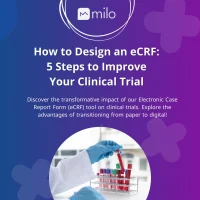In recent years, technology has been playing a central role in healthcare and clinical research developments. Among these welcomed innovations are electronic Case Report Forms, which are one of the electronic data capture tools that are revolutionizing the way we conduct clinical trials.
This article introduces Case Report Forms and explains the benefits of switching from their paper-based format to digital platforms. We will also share five strategies, in the form of five steps, to successfully create and implement an eCRF in a clinical study.
What is a Case Report Form?
This is a document that contains all relevant information about each participant in a clinical trial. It is the main tool used by researchers to collect patient data which will then be analyzed. Each participant will be related to one CRF, with answers to the questions that were previously determined by the study protocol. The questions in the case report form reflect the kind of data that the clinical trial needs to collect.
Case report forms are composed of a header with key informations such as study site and participant identification, a section of safety assessment questions and a section of efficacy assessment questions. This structure is used in traditional paper based CRFs, but also in their electronic version, which is the focus of this article and will be detailed in the next section.

How eCRFs Work ?
As the name indicates, electronic Case Report Forms are CRFs that are created, shared and filled in electronically. They are a type of electronic data capture (EDC) tool which is used in place of traditional paper-based questionnaires.
Therefore, electronic Case Report Forms work basically in the same way as physical forms, but they do not need to be printed and are shared and stored digitally. During the clinical trial, researchers will collect data from patients and feed it into the digital form, which is then automatically saved and is ready for analysis.
The Benefits of Using an eCRF
If they serve the same purpose as traditional CRFs, why should you choose to switch to electronic Case Report Forms? There are, in fact, many benefits of using these tools and this is why many medical companies and CROs have already stopped using paper to record data collection. These are some of the advantages of using these tools:
- Facilitating data storage: when using paper-based forms, a copy of the original source data needs to be kept for data security reasons. With electronic forms, no data duplication is needed because companies can comply with data security regulations using strong data management software and automatic back-ups.
- Reducing the risk of human error: the answers written in physical CRFs need to be manually transcribed to a computer database to be analyzed, creating a potential for copying errors and even missing data. With eCRFs, risks of data mishandling are reduced, increasing data quality and improving the clinical trial outcomes.
- Saving time: the time needed to print, pack, send and transcribe all those paper-based forms can be spent on more essential tasks, as digital data recording allows for instant sharing and reviewing of questionnaires.
- Allowing for remote clinical trial monitoring: researchers do not need to travel to the study site as many times as they would if they needed to access physical document storage. This not only reduces transportation costs, but also increases efficiency. Moreover, the data collected can be instantaneously accessed by everyone working in the study in a secure way.
- Increasing data security: paper can be lost, burnt, and inappropriately stored. Using digital forms means being able to use cloud systems which protect patient’s data from all risks associated with writing it on a piece of paper.
- Reducing the total cost of the clinical trial: this is a consequence of increasing efficiency and facilitating data storage. The amount spent on good EDC software will certainly pay off.
Five Steps to Design and Implement an Effective eCRF
Now that you already know what electronic Case Report Forms are and why you should be using them, you are ready to dive deeper into how they are created and implemented. In this section, we share some of our knowledge on how to design electronic Case Report Forms :
- Creating a study protocol: designing a study protocol is a prerequisite to design an eCRF. In our articles, we have already highlighted the importance of well-designed study protocols. It is the study protocol that will determine what kind of data will be collected and from which group of patients. During this stage, your main concerns should be whether the data required is relevant, so it results in relevant questions in the case report form, and if researchers will be dealing with sensitive data (participants’ personal information).
- Creating the form: now it’s time to actually design the form structure. Write the questions and set up consistency checks and data validations. These will instantly check the answers to questions and display an error message if they do not comply with the defined format. Then, define access to each part of the form. At this point, remember that clarity is key to avoid misinterpretation and mishandling of data: avoid acronyms and open-ended questions, indicate units of measurement and use images to illustrate instructions.
- Testing and training: before the form is ready to be used, it is recommended to test it with the research team and conduct training sessions, if necessary. When testing, ask for the team’s fedeback on usability, relevance and effectiveness. Check if each stakeholder’s action on the form is being tracked, to ensure data recording reliability.
- Validating: a last check before the clinical trial can begin. The sponsor will try the platform and check forms and data validation systems before validating the final version of the electronic Case Report Form to be used.
- Securing patient data: and finally, a last but very important step in the designing and implementation of your electronic case report form. Privacy of sensitive data and anonymity of participants must be ensured. Encryption and tokenization can be used to that end, making the most of technology in each stage of the form implementation.
Summary
- A Case Report Form is a document that contains all relevant information about each participant in a clinical trial.
- Electronic Case Report Forms are CRFs that are created, shared and filled in electronically.
- Some of the advantages of using these tools are facilitating data storage, reducing the risk of human error, saving time, allowing for remote clinical trial monitoring, increasing data security and reducing the total cost of the clinical trial.
- The five steps to design an eCRF are creating a study protocol, creating the form, testing and training, validating and securing patient data.







